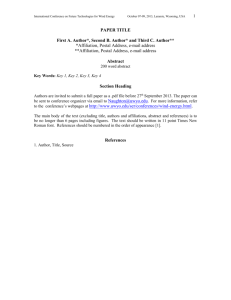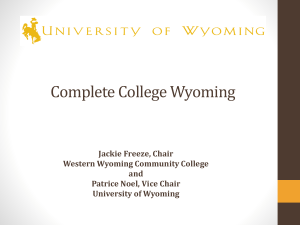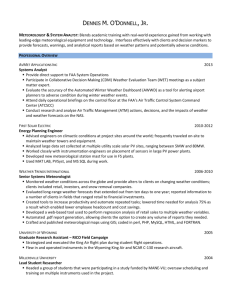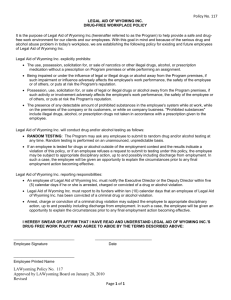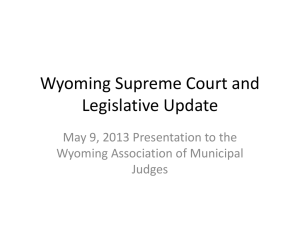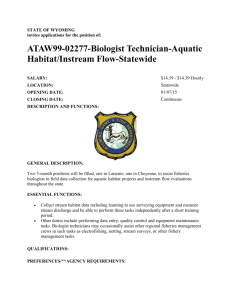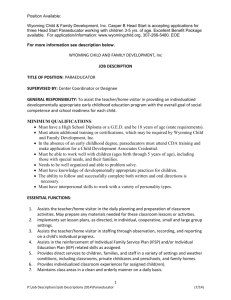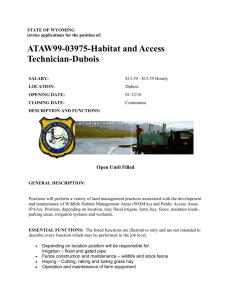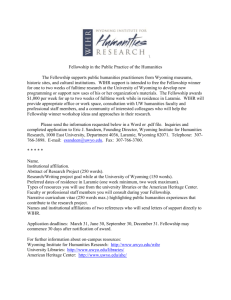(A) Quillinan: Identifying optimal, low
advertisement
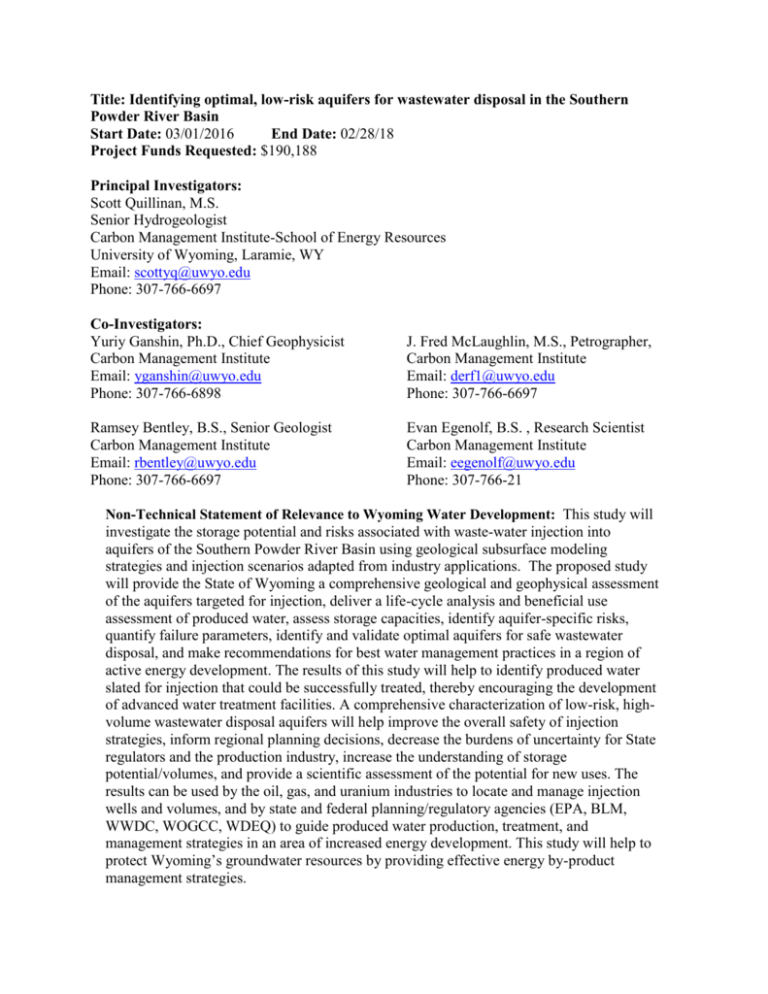
Title: Identifying optimal, low-risk aquifers for wastewater disposal in the Southern Powder River Basin Start Date: 03/01/2016 End Date: 02/28/18 Project Funds Requested: $190,188 Principal Investigators: Scott Quillinan, M.S. Senior Hydrogeologist Carbon Management Institute-School of Energy Resources University of Wyoming, Laramie, WY Email: scottyq@uwyo.edu Phone: 307-766-6697 Co-Investigators: Yuriy Ganshin, Ph.D., Chief Geophysicist Carbon Management Institute Email: yganshin@uwyo.edu Phone: 307-766-6898 J. Fred McLaughlin, M.S., Petrographer, Carbon Management Institute Email: derf1@uwyo.edu Phone: 307-766-6697 Ramsey Bentley, B.S., Senior Geologist Carbon Management Institute Email: rbentley@uwyo.edu Phone: 307-766-6697 Evan Egenolf, B.S. , Research Scientist Carbon Management Institute Email: eegenolf@uwyo.edu Phone: 307-766-21 Non-Technical Statement of Relevance to Wyoming Water Development: This study will investigate the storage potential and risks associated with waste-water injection into aquifers of the Southern Powder River Basin using geological subsurface modeling strategies and injection scenarios adapted from industry applications. The proposed study will provide the State of Wyoming a comprehensive geological and geophysical assessment of the aquifers targeted for injection, deliver a life-cycle analysis and beneficial use assessment of produced water, assess storage capacities, identify aquifer-specific risks, quantify failure parameters, identify and validate optimal aquifers for safe wastewater disposal, and make recommendations for best water management practices in a region of active energy development. The results of this study will help to identify produced water slated for injection that could be successfully treated, thereby encouraging the development of advanced water treatment facilities. A comprehensive characterization of low-risk, highvolume wastewater disposal aquifers will help improve the overall safety of injection strategies, inform regional planning decisions, decrease the burdens of uncertainty for State regulators and the production industry, increase the understanding of storage potential/volumes, and provide a scientific assessment of the potential for new uses. The results can be used by the oil, gas, and uranium industries to locate and manage injection wells and volumes, and by state and federal planning/regulatory agencies (EPA, BLM, WWDC, WOGCC, WDEQ) to guide produced water production, treatment, and management strategies in an area of increased energy development. This study will help to protect Wyoming’s groundwater resources by providing effective energy by-product management strategies. Title: Identifying optimal, low-risk aquifers for wastewater disposal in the Southern Powder River Basin Abstract: Water co-produced with oil and natural gas in Wyoming exceeds 1.9 billion barrels per annum. The most common produced water management practice in Wyoming is to reinject the water into subsurface saline aquifers. Injecting into deep saline aquifers introduces risks. Wastewater injection has been linked to induced seismicity in Oklahoma, and associations between injection well disposal and seismicity are currently under investigation in other areas. Other concerns arise regarding contamination to overlying fresh water aquifers, and the lack of adequate storage volumes in areas of new energy development. We propose to build high resolution 3-D property and dynamic fluid models for aquifers of the Southern Powder River Basin. Utilizing a 3-D seismic survey, geophysical well logs, core, and water quality data, we will calculate and identify velocity, time and depth maps, contrast in physical rock properties, fault location, fracture orientation, sealing capacity, rock strength, fracture gradient, porosity/permeability, pore pressure and storage capacity. We will consider the volume and water quality of produced water in the area and perform a life-cycle analysis to determine the best water treatment and management practices for produced water. These results will help improve the management of wastewater, and provide models to assess plume migration and volumetric effects of wastewater disposal in selected aquifers. These results can then be used to identify aquifers that satisfy the regulatory requirements set by Underground Injection Control managed by the Wyoming Department of Environmental Quality. Integrating the physical and regulatory constraints of wastewater injection will provide a guide for waste injection in the Southern Powder River Basin. Title: Identifying optimal, low-risk aquifers for wastewater disposal in the Southern Powder River Basin Statement of critical regional or State water problem: Water co-produced with oil and natural gas in Wyoming exceeds 1.9 billion barrels per annum1. Once at the surface, co-produced water requires management. The most common produced water management practice is to re-inject the water into subsurface saline aquifers. In Wyoming ~45% of all produced water (876 million Bbls per year) is re-injected to enhance oil recovery, and still more is injected into deep formations for disposal1. Injecting into deep saline aquifers introduces various risks. Wastewater injection has been linked to induced seismicity in Oklahoma, and associations between injection well disposal and seismicity are currently under investigation in other areas2, 3. Other concerns arise regarding risk to overlying fresh water aquifers, and the lack of potential storage aquifers in areas of new development. The Southern Powder River Basin (SPRB) has seen unprecedented oil and gas development in recent years. New development requires comprehensive, adaptable water management strategies, including locating new water waste disposal wells and disposal aquifers. In addition to new oil and gas development, wastewater injection and storage from regional uranium production increases the need for identifying low-risk aquifers in the SPRB. With a substantial need for produced wastewater management in the SPRB, investigating and validating low-risk injection aquifers is a priority for state regulators and industry partners. Research is needed to fill crucial information gaps to address the State of Wyoming’s Energy-Plan Strategy for produced water disposal including, 1) characterization of potential regional disposal aquifers and associated fluids, 2) developing advanced management strategies for beneficial uses and/or recovery potentials of produced water relative to specific chemistries and regional water-use needs, and 3) identification of optimal near-site aquifers for low-risk, high volume injection of produced water in areas of new oil and gas activity. To help meet the challenges of identifying low-risk injection aquifers for wastewater management, the Carbon Management Institute (CMI) proposes to utilize a proven interdisciplinary reservoir characterization technique. This includes assessing storage, injection risks, seismic attributes, dynamic injection modeling scenarios, geomechanics, and fluid geochemistry. CMI has extensive experience in identifying, characterizing, qualifying, and certifying low-risk storage reservoirs in Wyoming for the purpose of CO2 storage. For this project, CMI will adapt the reservoir assessment methodologies developed for CO2 storage for assessment of wastewater injection aquifers. The goal of this proposal is to fully investigate the risk associated with wastewater injection and to inform long-term produced water management plans. Statement of results or benefits: The proposed research will benefit both state and federal regulatory agencies and the oil and gas industry by providing the following: 1. 2. 3. 4. High-resolution property and physical assessments of aquifers in the SPRB Optimal water treatment scenarios for the SPRB Models to assess volumetric, pressure and geochemical effects of wastewater disposal Student intern training, publication and presentation of results Nature, scope, objectives, and timetable of activities: The objective of this study is to investigate injection risks in SPRB aquifers associated with wastewater disposal to help validate produced water management strategies. The specific tasks that will be undertaken to meet this objective include: 1. Comprehensive geological and geophysical aquifer characterization of potential injection aquifers 2. Life-cycle analysis and beneficial use assessment of produced water 3. Identification of and validation of lowest-risk aquifers for wastewater disposal in the Southern Powder River Basin 4. Recommendations for best water management practices Methods, procedures, and facilities: Task 1. Geological and geophysical aquifer characterization. We propose to employ an integrated, multi-disciplinary approach to develop a high-resolution property and physical assessment of aquifers in the Southern Powder River Basin. This will be accomplished by combining analysis and interpretations from a 3-D seismic survey, petrophysical data, available core, production assessment and life-cycle analysis, and water quality data4. Geometrical (morphological) attributes will be used to extract information on reflector dip, azimuth, and terminations, which can be related to faults, karst, and fractures. Physical attributes (seismic event magnitude, frequency and waveform characteristics, propagation velocity, etc.) will be used to estimate lithology, porosity, reservoir thickness, and porefluid content. Seismic trace properties, such as amplitude, phase, and frequency, will be correlated with petrophysical data. Selected seismic attributes that are statistically correlative will be effective for estimating aquifer properties across the seismic volume. In this study, both stacked amplitude volume and prestack common midpoint gathers will be used to perform the basic seismic measurements necessary to derive attributes. The basic parameters that were measured are travel-time, amplitude, waveform, and frequency from which we will calculate velocity, time and depth maps, contrast in physical rock properties, location of faults and dominant fracturing, dip magnitude and azimuth of beddings, and stratigraphic changes. Seismic attribute analysis will increase the analytical capacities of the project area relative to standard amplitude data, and further define volumetric analysis and storage assessments. Core containing intervals from selected aquifers will be requested for evaluation at the USGS Core Research Center in Golden, Colorado. Optimal sample locations will be defined from each core via integration of core inspection and geophysical log correlation. Core plug samples will be collected for the following analyses and preparations: thin section petrography, quantitative clay XRD/XRF, routine core analysis, mercury capillary displacement pressure Figure 1: Modified from Anna, 2009 illustrates the analysis, and triaxial shear testing. lateral extent of the Niobrara Fm. (pink polygon) Converse County SPRB, and the location Thin sections will be impregnated with a dyed epoxy for underlying of the Brown Springs seismic survey (blue rectangle) porosity quantification and analysis, as well as stained to and oil (green dot) and gas (red dot) wells. evaluate the character of cementation. Thin sections will be evaluated at CMI using a Zeiss petrographic microscope and both in-house and commercial analytical software. A portion (approximately 5-10 g) of some samples will be retained and powdered for XRD/XRF analysis. These samples will be powdered and processed for XRD/XRF analysis including pressed to form a pellet, melted to create a glass bead, or treated with glycol to orient clay samples. Core plugs from aquifers will be analyzed at reservoir conditions for axial and radial strain responses. These data will provide mechanical strength data for the selected reservoirs, which will be correlated to risks from pressure during injection phases. Analysis will be done on equipment in the Geology and Geophysics Department, or at laboratories in the Engineering Department at the University of Wyoming. Selected plugs will be analyzed for porosity and permeability. Apparent grain density will be calculated from dry weight and grain volume. Pore volume and permeability measurements will be made with the samples mounted in a rubber-sleeved, hydrostatically loaded overburden cell. Samples will be tested at 800 psig and then calculated at reservoir net confining stress. Boyle’s Law principle, using helium as the gas medium, will be used to determine pore volume. Unsteady-state Klinkenberg permeability will be measured concurrent to pore volume measurement. Selected samples will be analyzed for mercury capillary displacement pressure and pore throat sizes/distribution. Samples will be subjected to mercury injection in a vacuumed porosimeter until entry pressures are reached. Analysis will likely be done at a commercial facility. Core analysis will be used to refine geological and geophysical property models, assess the potential for formation damage during wastewater injection, and provide mechanical property data for aquifers of interest relative to fracture potential. Task 2. Life-cycle analysis, treatment, and management program. Available water quality databases will be queried to identify produced water samples with a full-suite of analytical data. These data will be examined for statistical relevance and used to estimate baseline water quality for regional aquifers. Regional water use will be assessed by type and volume. On the basis of statistical assessment and the potential beneficial use of the region, CMI will identify optimal water treatment scenarios for the SPRB. These data will also be used in Task 3, to populate geochemical injection models. Task 3. Identify optimal, compatible and low-risk aquifers for reinjection. All data from previous tasks will be combined to populate a property model for dynamic injection assessments. Reservoir engineering principles will be utilized to build injection/storage scenarios for wastewater using the geologic property model. Analytical parameters from previous tasks will be evaluated in order to upscale into a dynamic fluid model. Critical parameters include volumetrics, permeability and porosity, reservoir pressure and porepressure analysis, pressure volume temperature analysis of all fluids, and rock fluid interactions. Qualitative calculations relative to the final fluid model will be made to estimate storage capacities of potential reservoirs, and to determine the physical feasibility of injection. After the property model is fully integrated and up scaled, dynamic injection scenarios will be modeled using a reservoir simulator. These scenarios will define quantitative volumetrics relative to injection rates/volumes and plume migration responses, and qualitatively assess reactions to various wastewater injection scenarios (pressure, fracture response, etc.). Reservoir simulations will show the effects of different injection realizations and reduce uncertainties relative to storage capacity. Conclusions from the dynamic injection scenarios will help improve the safety of the design of storing these waste products, and provide models to assess plume migration and volumetric effects of wastewater disposal in selected aquifers. The petrographic results will be integrated with the water quality data to generate geochemical models that will estimate geochemical reactions in the fluid and rock system. These results will be used to identify compatible fluids and aquifers are at low- risk to formation damage (mineral scale, loss of injectivity, and formation of H2S). Task 4. Develop recommendations to identify and characterize low-risk aquifers for effective wastewater injection. All conclusions from previous tasks will be compiled into a final report. The report will detail the best aquifers/zones for low-risk waste-water injection in the SPRB. The final report will include recommendations for methodologies and best practices needed to duplicate this study in other areas of Wyoming, detail the impacts of wastewater injection on aquifers relative to the injection models, and define the parameters that are critical to assessing potential risks. Related research: One of the biggest challenges with large volume injection is pressure management. The host brine must be displaced in injection zones, and the resulting migration can result in pressure fronts, breakthroughs, and even fracturing of the aquifer matrix. Key questions must be addressed to avoid adverse effects. Is the accommodation space sufficient? Given the geologic heterogeneity, can fluid migration pathways be maintained without disrupting the confining units and compromising the integrity of the fluid/rock system? What are the largest uncertainties relative to the geologic character of the injection aquifer, confining units, and study site? In many geological formations in Rocky Mountain Basins, injected fluids have the potential to increase formation pressure above natural fracture pressures5. This problem is well known and even manipulated during hydraulic fracturing processes. However, unexpected induced fractures can cause extensive damage (e.g. earth quakes, leakage, faults, and fractures). Induced seismicity has been linked to wastewater injection in Oklahoma and Colorado, and is under investigation in Texas, Arkansas, Colorado, New Mexico, and Ohio2,3. Recent work from the Wyoming State Geological Survey6 found little relationship between the number, size, and location of earthquakes and the location of Class II injection wells in Wyoming. However, most induced seismicity to-date has been found to be associated with injection into non-producing formations with native pressures3. Nonproducing formations are more susceptible to failure during injection than similar formations that become under-pressured as a result of oil and gas production. Assessment of injection impacts on these aquifers is critical to produced water management in Wyoming, and the multi-disciplinary aquifer characterization and injection modeling proposed in this study can lay the groundwork for this discussion. Recent work funded through the WWDC provides a statistical analysis of water quality and descriptions of the hydrogeology4. This work will provide the hydrogeological foundation for this study, and allow for site-specific results to be projected outside of the seismic domain. Current groundwater salinity mapping by the Wyoming State Geological Survey7 will also provide foundational data for statistical water quality assessments. CMI has completed several reservoir and seal characterization projects to identify, investigate, and certify low-risk saline injection/storage reservoirs in Wyoming and China5, 9-15 . This project will utilize the current expertise and methodologies developed by CMI that has been/is being used to validate reservoir pressure management and plume control strategies through brine extraction and treatment in southwest WY (DE-FE0021659, DEFE0009202), assessing feasible uses of produced water/life-cycle produced water assessments (SER Rare Earth Element Research Funding) and develop an integrated strategy for extracted water treatment and enhanced oil recovery in the Ordos Basin in China through complex, stacked reservoir management (DE-PI0000017). References cited: 1. Wyoming Oil and Gas Commission Website; http://wogcc.state.wy.us 2. Keranen, K., Savage, H., Abers, G., and Cochran, E., Potentially induced earthquakes in Oklahoma, USA: Links between wastewater injection and the 2011 M 5.7 earthquake, Geology, v. 41, no. 6, pps 699-702 3. Ellsworth, W., 2013, Injection-induced earth quakes, Science, vo. 341, no., 6142. 4. Taucher, P., Bartos, T.T., Taboga, K.G., Hallberg, L.L, Clark, M.L., Stafford, J., Gracias, T., Hinckley, B., Worman, B., Clarey, K., Lindemann, L., Quillinan, S.A., Copeland, D., Hays, R., and Thompson, M., 2013, Available Groundwater Determination Technical Memorandum, WWDC Platte River Basin Water Plan Update, Level I (2009-2013), Wyoming State Geological Survey, Laramie, Wyoming. 481 p. 5. Surdam RC, Jiao ZS, Stauffer P, Miller T, 2009, An integrated strategy for carbon management combining geological CO2 sequestration, displaced fluid production and water treatment. Wyoming State Geological Survey Challenges in Geological Resource Development no. 8 6. Quillinan, S.A. and McLaughlin, J.F., 2013, Reservoir Fluid Characterization of the Weber Sandstone and Madison Limestone on the Rock Springs Uplift in Southwest Wyoming, in Surdam, R.C. (eds), Characterization of Geological CO2 storage sites: Strategy for optimizing and implementing storage, Springer, pp. 151-169 7. Anna, L.O., 2009, Geologic assessment of undiscovered Oil and Gas in the Powder River Basin Province, Wyoming and Montana, Digital Data Series DDS-69-U 8. Larson, M.C., and Wittke, S. J., 2014, Relationships between injection and disposal well activities and known earthquakes in Wyoming, from 1984 to 2013, Open File Report 2014-05 9. Taboga, K., personal communication, Wyoming State Geological Survey 10. Surdam, R.C. (eds), 2013 Characterization of Geological CO2 storage sites: Strategy for optimizing and implementing storage, Springer 11. McLaughlin, J.F., Bentley, R.D., Quillinan, S.A., (2014) Regional geologic history, CO2 source inventory, and groundwater risk assessment of a potential CO2 sequestration site on the Rock Springs Uplift in Southwest Wyoming, in Surdam, R.C. (eds), Characterization of Geological CO2 storage sites: Strategy for optimizing and implementing storage, Springer pp. 33-55 12. McLaughlin, J.F., Quillinan, S.A., Jiao, Z., (2014) Geologic Controls on Sealing Capacity; Defining Heterogeneity Relative to Long-Term CO2 Storage Potential in Wyoming, The thirteenth Annual Carbon Capture, Utilization and Storage Conference: Accelerating Deployment to meet New CO2 Emission Reduction Mandates, Abstract # 89 13. McLaughlin, J.F., Quillinan, S.A., Jiao, Z., Surdam, R.C., 2013, Refining reservoir estimates and long-term CO2 storage capabilities by reducing geologic uncertainties: Petrographic and geochemical evaluation of potential reservoirs, seals and associated formation fluids in southwest Wyoming, 1A-Storage Capacity, Abstract #213, Carbon Capture, Utilization and Storage Conference, Pittsburgh, PA May 2013 14. Quillinan, S.A., Surdam, R.C., McLaughlin, J.F., (2013) An Integrative Strategy to Increase the Economic Feasibility of CO2 sequestration: Mining Brines from Saline Storage Reservoirs, Session No. 313, T80. Geology for the Common Good: Sustainable Resources for the 21st Century, Geological Society of America Abstracts with Programs, Vol. 45, No. 7, Paper No. 313-11 15. Surdam, R.C., and Quillinan, S.A., (2013) Displaced fluid management – Key to commercial-scale geologic storage, in Surdam, R.C. (eds), Characterization of Geological CO2 storage sites: Strategy for optimizing and implementing storage, Springer, pp. 233-245 Training potential: CMI is requesting funds from the Water Research Program to fund one geology or engineering undergraduate/graduate student intern for three months of each year of the project. The intern will be employed during the summer months of 2016 and 2017. The student will gain working knowledge of reservoir/aquifer characterization, and have the potential to make beneficial networking relationships with industry professionals and state/federal agencies. Investigators qualifications: Researchers at the Carbon Management Institute have applied interdisciplinary competencies in geology, geophysics, petrology, hydrogeology, geochemistry, and reservoir engineering. Scott Quillinan is a registered Professional Geologist and Senior Hydrogeologist for the School of Energy Resources-Carbon Management Institute (CMI), at the University of Wyoming. Quillinan’s research focuses on the challenges associated with interconnections between energy resource production and groundwater resources. He has worked with groundwater challenges associated with the production of coal, coalbed methane, oil and gas, hydraulic fracturing and CO2 sequestration; specializing in predicting and identifying water/rock geochemical reactions, isotopic groundwater tracing, confined and unconfined aquifers, efficient reservoir dewatering techniques, and identifying beneficial use for produced waters. J. Fred McLaughlin is a registered Professional Geologist and Senior Petrographer for the CMI. Areas of research include isotopic and geochemical evolution of basement and sedimentary rocks and groundwater, geochemistry and petrology, natural gas, uranium and coal systems, and the evolution of reservoirs. McLaughlin has extensive experience analyzing the petrogenic evolution of lithics through the interpretation of cores, geochemistry, and thin sections. Yuri Ganshin is a Senior Geophysicist for CMI. Dr. Ganshin's primary research interest is in the development and calibration of new and conventional seismic attributes to aid in seismic processing, seismic interpretation, and reservoir/seal characterization. Recent work has focused on applying detailed seismic velocity analysis, spectral decomposition, coherence, and volumetric curvature to attribute-assisted processing as well as mapping fractures, karst, and hydrocarbons. His special interest is in development of computer software for automated, high-resolution velocity analysis that facilitates subsurface imaging. Evan Egenolf is a research associate for CMI and a licensed Engineer in Training in the state of Wyoming. Evan has spent most of his time in reservoir engineering, enhanced oil recovery, and simulation during his stints in industry and academic study. Ramsey D. Bentley is a registered Professional Geologist CMI, at the University of Wyoming. Bentley has 30 years of oil and gas related experience, mainly in Wyoming and surrounding states. His areas of research have focused on oil and gas and CO2 reservoirs and potential storage sites through the use of petrophysical log applications and interpretations. SCOTT A. QUILLINAN P.G. Senior Hydrogeologist, Carbon Management Institute, School of Energy Resources The University of Wyoming 2020 Grand Avenue, suite 500 Laramie, WY 82072, (307) 766-6697, scottyq@uwyo.edu Education/Certification: 2012 2008-2011 2002-2006 Registered Professional Geologist, No. PG-3824, State of Wyoming M.S. Geology, University of Wyoming B.S., Geology, University of Wyoming Positions: 2012-Present 2009-2012 2006-2009 2005-2006 Senior Hydrogeologist, Carbon Management Institute, School of Energy Resources-University of Wyoming, Laramie, WY Project Geologist, Groundwater Program Coordinator, Wyoming State Geological Survey, Laramie WY Geologist, Unconventionals, Wyoming State Geological Survey, Laramie Wyoming Research Associate, Coal Geology, Wyoming State Geological Survey, Laramie WY Relevant Publications: 1. Quillinan S.A., and Frost, C.D., (2013) Carbon isotope characterization of Powder River Basin coal bed waters: Key to minimizing unnecessary water production and implications for exploration and production of biogenic gas, in Karacan, C.O., Soeder, D., and Engle, M., Environmental Geology and the Unconventional Gas Revolution, International Journal of Coal Geology 2. Quillinan, S.A. and McLaughlin, J.F., (2013), Reservoir Fluid Characterization of the Weber Sandstone and Madison Limestone on the Rock Springs Uplift in Southwest Wyoming, in Surdam, R.C. (eds), Characterization of Geological CO2 storage sites: Strategy for optimizing and implementing storage, Springer, pp. 151-169 3. Surdam, R.C., and Quillinan, S.A., (2013) Displaced fluid management – Key to commercial-scale geologic storage, in Surdam, R.C. (eds), Characterization of Geological CO2 storage sites: Strategy for optimizing and implementing storage, Springer, pp. 233-245 4. Quillinan, S.A., Surdam, R.C., McLaughlin, J.F., (2013) An Integrative Strategy to Increase the Economic Feasibility of CO2 sequestration: Mining Brines from Saline Storage Reservoirs, Session No. 313, T80. Geology for the Common Good: Sustainable Resources for the 21st Century, Geological Society of America Abstracts with Programs, Vol. 45, No. 7, Paper No. 313-11 5. Quillinan, S.A., and Frost, C.D., 2012, Spatial variability of coalbed natural gas produced water quality, Powder River Basin, Wyoming: Implications for future development, Wyoming State Geological Survey Report of Investigation No. 64-2012 56p. 6. McLaughlin, J.F., Bentley, R.D., Quillinan, S.A., (2014) Regional geologic history, CO2 source inventory, and groundwater risk assessment of a potential CO2 sequestration site on the Rock Springs Uplift in Southwest Wyoming, in Surdam, R.C. (eds), Characterization of Geological CO2 storage sites: Strategy for optimizing and implementing storage, Springer pp. 33-55 7. Quillinan, S.A., McLaughlin, J.F., and Bentley, R., (2014) The Geochemical Characterization of Reservoir Fluids: Defining the Fluid and Rock System and Identifying Changes to Baseline Conditions Due to Well Completion, The thirteenth Annual Carbon Capture, Utilization and Storage Conference: Accelerating Deployment to meet New CO2 Emission Reduction Mandates, Abstract # 43, April 30, 2014 8. Quillinan, S.A., McLaughlin, J.F., and Frost C.D., 2012, Geochemical and stable isotopic analysis of the Tongue River and associated tributaries in the Powder River Basin: An analysis of the cause of annual elevated salinity in spring runoff, Wyoming State Geological Survey Report of Investigations No. 63-2012 15p. 9. Jones, N.R., Quillinan, S.A., Hays, R.J., Rodgers, J.R., 2006, Net coal thickness within the Powder River watershed Wyoming ,Wyoming State Geological Survey Open File Report OFR 06-9, 1:200,000 10. Quillinan, S.A., 2007, Perimeter Sedimentation in a depression swamp as an alternative to raised mires as a means of accumulating low-ash peat, Geological Society of America Abstracts with Programs, Vol. 39, No. 5, p. 14. 11. Jones, N.R., Quillinan, S.A., and McClurg, J., (2009), Wyoming Coal, Wyoming State Geological Survey Public Information Circular No. 44 12. Quillinan, S.A., Wormen, B., Rodgers, J.R., (2009), Coalbed Natural Gas Activity in the Atlantic Rim area, south central, Wyoming, Wyoming State Geological Survey Open File Report OFR 09-7 scale 1:100,000 13. McLaughlin, J.F., Quillinan, S.A., Jiao, Z., (2014) Geologic Controls on Sealing Capacity; Defining Heterogeneity Relative to Long-Term CO2 Storage Potential in Wyoming, The thirteenth Annual Carbon Capture, Utilization and Storage Conference: Accelerating Deployment to meet New CO2 Emission Reduction Mandates, Abstract # 89, April 30, 2014 14. Surdam, R., Jiao, Z., Ganshin, Y., Bentley, M., Garcia-Gonzalez, Quillinan, S.A., McLaughlin, J.F., Stauffer, P., Deng, H., (2013) Detailed CO2 Storage Reservoir Site Characterization: The Key to Optimizing Performance and Maximizing Storage Capacity, AAPG Annual Convention, Pittsburgh, PA 15. McLaughlin, J.F., Quillinan, S.A., Surdam, R.C., 2012, Characterizing diagenesis and its opposing impacts on porosity in the Weber and Madison Formations in southwest Wyoming: Applying geochemical, petrographic, and isotopic analysis to describe reservoir heterogeneity in potential CO2 storage sites, Geological Society of America Abstracts with Programs, Vol. 44, No. 7, p. 151, GSA Annual Convention, November 4th , 2012, Charlotte, North Carolina Synergistic Activities: 2015 2012 2009-2012 2009-2012 2008-2010 2007-2010 International Organization for Standardization, Working group on Carbon Dioxide Storage through Enhanced Oil Recovery, TC-265, Technical Advisory Group Hydraulic Fracturing Investigation at Pavillion, WY Technical Team member, State of Wyoming Technical Representative University of Wyoming Water Research Program, Member of the Priority and Selection Committee State of Wyoming Ambient Groundwater Monitoring Program, Member of the Steering Committee Wyoming-Shanxi, China Energy Cooperation Project, Wyoming International Delegation Technical Team Unconventional Fuels Task Force (see EPACT 2005 S. 369h.), Wyoming Representative Yuriy V. Ganshin, PhD Chief Geophysicist, Carbon Management Institute, School of Energy Resources The University of Wyoming 2020 Grand Avenue, suite 500 Laramie, WY 82072, (307) 766-6898, yganshin@uwyo.edu Professional Profile: I have extensive experience in geophysical data analysis, including surface seismic processing and interpretation, vertical seismic profiling, and well log calibration to seismic. I have also participated in several research projects associated with the subsurface imaging for reservoir/seal characterization in Wyoming Laramide Basins. I am also very adept in developing and operating computer applications. Employment History: 1997-1999 1999-2001 2001-2004 2004-2005 2005-2011 2011- Post-Doctoral Research Associate, Dept. Geology/Geophysics, UWYO, Laramie, WY Research Scientist Assistant, Institute for Energy Research at UWYO, Laramie, WY Senior Geophysicist, Innovative Discovery Technologies (IDT) LLC, Laramie, WY Senior Geophysical Analyst, Julander Energy Company, Denver, CO Geophysicist, Wyoming State Geological Survey, Laramie, WY Chief Geophysicist, CMI, University of Wyoming, Laramie, WY Education: 1997 Ph.D. in Geology, University of Wyoming, Laramie, Wyoming 1978 M.Sc. in Geophysics, State Mining University, St. Petersburg, Russia Professional Interests and Skills: (a) Seismic studies of different scales and dimensions, seismic attribute analysis (b) Geophysical modeling and reservoir characterization (b) Seismic monitoring of fluid injection/production processes (c) Petrophysical and statistical well-log analysis (e) Computer software engineering for geology/geophysical applications Selected publications (in chronological order): 1. Ganshin YV, Smithson SB, Morozov IB, Smythe DK, Garipov VZ, Karaev NA, Kristoferson Y. Seismic studies around the Kola Superdeep Borehole, Russia. Tectonophysics 288, pp 1-16, 1998. 2. Ganshin YV, Surdam RC, and Jiao ZS. Detection of anomalously pressured gas reservoirs: 2-D seismic surveys in the Wind River Basin, Wyoming. AAPG Search and Discovery Article #90004, AAPG Rocky Mountain Section, 2002. 3. Surdam RC, Jiao ZS, and Ganshin YV. Reducing the risk of exploring for anomalously pressured gas assets. GasTIPS, Winter 2004, 4. 4. Surdam RC, Jiao ZS, and Ganshin YV. A new approach to exploring for anomalously pressured gas accumulations. Exploration Memoir No. 1. Wyoming State Geological Survey, 2005. 5. Ganshin YV, Quillinan SA, Surdam RC. Mapping an Almond Bar wedge at Stagecoach Draw Field, southwestern Wyoming: Application of Spectral Decomposition Technique. Report of Investigations No. 59. Wyoming State Geological Survey, 2010. 6. Surdam RC, Ganshin YV, and Jiao ZS. Burial history, thermal maturity, and seismic attributes at Cow Creek Field: A study of the reservoir and source rocks, Washakie Basin, Wyoming. Report of Investigations No. 61. Wyoming State Geological Survey, 2010. 7. Ganshin YV. Velocity trends in Cretaceous rocks in Wyoming Laramide basins. Report of Investigations No. 62. Wyoming State Geological Survey, 2012. 8. Surdam, R.C., Ganshin, Y., Copeland, D., Jiao, Z., Quillinan, S.A., Bentley, 2013, Relative permeability of the Middle Madison Reservoir, Sequestration Reservoir Studies/Evaluations, Abstract #229, Carbon Capture, Utilization and Storage Conference, Pittsburgh, PA May 2013. 9. Yuri Ganshin and Ronald C. Surdam, 2013, Utility of 3-D Seismic Attribute Analysis and VSP for Assessing Potential Carbon Sequestration Targets on the Rock Springs Uplift, Southwest Wyoming: in Ronald C. Surdam editor, Geological CO2 Storage Characterization, Chapter 7, pp. 97-150, Springer. 10. Yuri Ganshin, 2013, Predicting Permeability in the Target Reservoirs of the Rock Springs Uplift, Southwest Wyoming: in Ronald C. Surdam editor, Geological CO2 Storage Characterization, Chapter 9, pp. 169-190, Springer J. FRED MCLAUGHLIN P.G. Senior Petrographer, Carbon Management Institute, School of Energy Resources The University of Wyoming 2020 Grand Avenue, suite 500 Laramie, WY 82072, (307) 766-6685, derf1@uwyo.edu Education/Certification: 2011-2015 (expected) Ph.D. Geology, University of Wyoming 2006-2009 M.S. Geology, University of Wyoming 1999-2004 B.S., Geology, University of Wyoming Positions: 2012-Present Senior Petrographer, Carbon Management Institute, School of Energy ResourcesUniversity of Wyoming, Laramie, WY 2008-2012 Geologic Manager, Wyoming State Geological Survey, Laramie WY 2004-2008 Geologic Analyst, Wyoming State Geological Survey, Laramie Wyoming Professional Affiliations: 2012 2014 Registered Professional Geologist, No. PG-3824, State of Wyoming Division Officer, Energy Geology Division. Geological Society of America Relevant Publications: 1. McLaughlin, J. F., Ganshin, Y., Quillinan, S., Bentley, R., & Jiao, Z., 2014. Mitigating Risks Associated with Long-term CCS: Characterizing the Geologic History and Heterogeneity of Sealing Strata. Energy Procedia, 63, 4999-5009. 2. McLaughlin, J. F., & Garcia-Gonzalez, M., 2013. Detailed Geologic Characterization of Core and Well Data from the Weber and Madison Formations and Associated Seals at a Potential CO2 Sequestration Site in Southwest Wyoming: Defining the Lithologic, Geochemical, Diagenetic, and Burial Histories Relative to Successful CO2 Storage. Geological CO2 Storage Characterization: The Key to Deploying Clean Fossil Energy Technology, 55-96. 3. McLaughlin, J. F., Bentley, R. D., & Quillinan, S. A., 2013. Regional Geologic History, CO2 Source Inventory, and Groundwater Risk Assessment of a Potential CO2 Sequestration Site on the Rock Springs Uplift in Southwest Wyoming. In Geological CO2 Storage Characterization (pp. 33-54). Springer New York. 4. McLaughlin, J.F., Quillinan, S,A, and Frost, C.D., 2013. Geochemical evolution of deep saline brines from Paleozoic reservoirs in southwest Wyoming; implications for potential CO2 sequestration, Session No. 60, T255. Produced Waters: Characterization and impacts of subsurface brines and formation water associated with hydrocarbon production (Posters), Geological Society of America Abstracts with Programs. Vol. 45 No. 7 5. McLaughlin, J.F., Bentley, R.D., Quillinan, S.A., 2014. Regional geologic history, CO2 source inventory, and groundwater risk assessment of a potential CO2 sequestration site on the Rock Springs Uplift in Southwest Wyoming, in Surdam, R.C. (eds), Characterization of Geological CO2 storage sites: Strategy for optimizing and implementing storage, Springer pp. 33-55 6. McLaughlin, J.F., Frost, C.D., Sharma, S., 2011. Isotopic analysis of Atlantic Rim waters, Carbon County, Wyoming: A new tool for characterizing coalbed natural gas systems. AAPG Bulletin vol .95, no. 2. P. 191-217 7. McLaughlin, J.F., Quillinan, S.A., Jiao, Z., 2014. Geologic Controls on Sealing Capacity; Defining Heterogeneity Relative to Long-Term CO2 Storage Potential in Wyoming, The thirteenth Annual Carbon Capture, Utilization and Storage Conference: Accelerating Deployment to meet New CO2 Emission Reduction Mandates, Abstract # 89, April 30, 2014 8. McLaughlin, J.F., Quillinan, S.A., Jiao, Z., Surdam, R.C., 2013. Refining reservoir estimates and long-term CO2 storage capabilities by reducing geologic uncertainties: Petrographic and geochemical evaluation of potential reservoirs, seals and associated formation fluids in southwest Wyoming, 1A-Storage Capacity, Abstract #213, Carbon Capture, Utilization and Storage Conference, Pittsburgh, PA May 2013 9. McLaughlin, J.F., Quillinan, S.A., Surdam, R.C., 2012. Characterizing diagenesis and its opposing impacts on porosity in the Weber and Madison Formations in southwest Wyoming: Applying geochemical, petrographic, and isotopic analysis to describe reservoir heterogeneity in potential CO2 storage sites, Geological Society of America Abstracts with Programs, Vol. 44, No. 7, p. 151, GSA Annual Convention, November 4th, 2012, Charlotte, North Carolina 10. McLaughlin, J.F., Quillinan, S.A., Surdam, R.C., Bentley, R., Ganshin, Y, 2013. Dolomitization of Madison Limestone in the Green River Basin, Wyoming; Geochemical Evidence for Low Temperature Diagenesis and the Relation to Regional Porosity Trends, AAPG annual convention, Pittsburgh, PA 11. Quillinan, S.A. and McLaughlin, J.F., 2013. Reservoir Fluid Characterization of the Weber Sandstone and Madison Limestone on the Rock Springs Uplift in Southwest Wyoming, in Surdam, R.C. (eds), Characterization of Geological CO2 storage sites: Strategy for optimizing and implementing storage, Springer, pp. 151-169 12. Quillinan, S.A., McLaughlin, J.F., and Frost C.D., 2012, Geochemical and stable isotopic analysis of the Tongue River and associated tributaries in the Powder River Basin: An analysis of the cause of annual elevated salinity in spring runoff, Wyoming State Geological Survey Report of Investigations No. 63-2012 15p. Ramsey D. Bentley, Senior Geologist, Carbon Management Institute (307) 766-‐6833 Education and Training University of Wyoming, Laramie B.S., Sociology, 1974 B.S., Geology, 1980 State of Wyoming Professional Geologist, Registration Number PG--‐1264 Research and Professional Experience Senior Geologist, Carbon Management Institute, University of Wyoming, 2011--‐Present Geological Manager, Wyoming State Geological Survey, 2009--‐2011 Staff Geologist, Wyoming State Geological Survey, 2004--‐2009 Oil and Gas Geologist, Bureau of Land Management, 1984--‐1996 Oil and Gas Geologist, Duncan Oil Properties, 1980--‐1982 Selected Recent Publications 1. Surdam, R.C. (Ed.), 2013, Geological CO2 Storage Characterization: The Key to Deploying Clean Fossil Energy. Springer Verlag, p.301. 2. McLaughlin, J.F., Quillinan, S.A., Surdam, R.C., Bentley, R., Ganshin, Y, (2013) Dolomitization of Madison Limestone in the Green River Basin, Wyoming; Geochemical Evidence for Low Temperature Diagenesis and the Relation to Regional Porosity Trends, AAPG annual convention, Pittsburgh, PA 3. Surdam, R.C., Bentley, R., Jiao, Z., McLaughlin, J.F., Quillinan, S.A, .Ganshin, Y., 2013, The importance of CO2 storage in designing strategies for sustainable development of energy resources, 2C-Utilizing Anthropogenic CO2 for EOR and other beneficial uses, Abstract #283, Carbon Capture, Utilization and Storage Conference, Pittsburgh, PA May 2013 4. Bentley, R., Kirkwood, R., Surdam, R.C., Copeland, D., Jiao Z., McLaughlin, J.F., Quillinan, S.A., 2013, Carbon Dioxide (CO2) sources in Wyoming: Mapping a carbon management strategy, EOR Abstract #285, Carbon Capture, Utilization and Storage Conference, Pittsburgh, PA May 2013 5. Stauffer, P.H., Surdam, R.C., Jiao, Z., Miller, T.A., and Bentley, R.D., 2009, Combining geologic data and numerical modeling to improve estimates of the CO2 sequestration potential of the Rock Springs Uplift, Wyoming: Energy Procedia, v. 1, Elsevier, pp. 2717–2724 6. Bentley, R.D., Lusk, A., 2008, Clean coal technology, carbon capture and sequestration, and enhanced oil recovery in Wyoming’s Powder River Basin, an integrated approach: Wyoming State Geological Survey Challenges in Geologic Resource Development No. 7, 2008 EVAN P. EGENOLF Assistant Research Associate, Carbon Management Institute, School of Energy Resources The University of Wyoming 2020 Grand Avenue, suite 500 Laramie, WY 82072, (307) 766-6697, eegenolf@uwyo.edu Education/Certification: 2015 2015 Engineer in Training, No. 6049, State of Wyoming B.S., Petroleum Engineering, University of Wyoming Positions: 2015-Present Summer 2014 Summer 2013 2011-2015 Associate Research Scientist, Carbon Management Institute, Laramie WY Reservoir & EOR Engineering Intern, Pioneer Oil Company, Lawrenceville IL Project Coordinator, Lindal Group, Columbus IN ASU Support, University of Wyoming Information Technology, Laramie WY Relevant Publications: 1. Egenolf, E.P., 2015, Pore-pressure prediction in sedimentary rocks using seismic data acquired at the Rock Springs Uplift (RSU) in southwestern Wyoming, Geological Society of America Abstracts with Programs, Vol. 47, No. 26, GSA Annual Convention, November 1st, 2015, Baltimore, Maryland Synergistic Activities: 2015 Anadarko Excellence in Energy Fellowship 2014 PETROBOWL Team Member 2011-Present SPE member YEAR 1 BUDGET (FY16) Start Date of FY16: 3/1/16 End Date of FY16: 2/28/17 Project Title: Identifying optimal, low-risk aquifers for waste water disposal in the Southern Powder River Basin Principal Investigators (names only -- i.e., no addresses etc.): Scott A. Quillinan, Yuriy Ganshin, J.Fred McLaughlin, Ramsey Bentley, Evan Egenolf Cost Category 1. Salaries and Wages - - - - - - - - - - - - - - - - - - - - - - - - - - - Totals Principal Investigator(s) Request 64,167 53667 UW 13,850 13850 Total 78,017 67517 0 0 10500 0 29,870 6,447 36,317 24982 6447 31429 0 0 0 Graduate Student(s) on assistantships (i.e., stipends) Undergraduate or Grad Student(s) employed hourly Others, full-time benefited 10500 Others, part-time non-benefited 2. Fringe Benefits - - - - - - - - - - - - - - - - - - - - - - - - - - - - - - - Totals Principal Investigator(s), 46.55% Graduate Student(s) on assistantships, 1% Undergraduate or Grad Student(s) employed hourly, 9% Others, full-time benefited, 46.55% Others, part-time non-benefited, 20% 3. Graduate Student Tuition, Fees, Health Insurance- - - - - Totals 0 0 0 4888 0 4888 0 0 0 0 0 0 Tuition and Fees 0 Health Insurance 0 0 4. Supplies - - - - - - - - - - - - - - - - - - - - - - - - - - - - - - - - - - - - - - - 5. Equipment - - - - - - - - - - - - - - - - - - - - - - - - - - - - - - - - - - Totals Individual items costing $5,000 or less 500 0 500 500 500 6. Services or Consultants - - - - - - - - - - - - - - - - - - - - - - - - - - - - - 5,000 5,000 7. Travel - - - - - - - - - - - - - - - - - - - - - - - - - - - - - - - - - - - - - - - - - - - 1,640 1,640 Individual items in excess of $5,000 0 0 8. Other Direct Costs - - - - - - - - - - - - - - - - - - - - - - - - - - - - - - - - 101,177 XXXXXX X 20,297 121,474 53,449 53,449 Indirect costs on federal share xxxxxxxx 44518 44518 Indirect costs on non-federal share xxxxxxxx 8931 8931 73,746 174,922 9. Total Direct Costs* - - - - - - - - - - - - - - - - - - - - - - - - - - - - - - - - 10. Total Indirect Costs - - - - - - - - - - - - - - - - - - - - - - - - - - - - - - - - (0.44 direct, except grad tuition/fees/health ins & equip>$5000) 11. Total Cost - - - - - - - - - - - - - - - - - - - - - - - - - - - - - - - - - - - - 101,177 YEAR 2 BUDGET (FY17) Start Date of FY16: 3/1/17 End Date of FY16: 2/28/18 Project Title: Identifying optimal, low-risk aquifers for waste water disposal in the Southern Powder River Basin Principal Investigators (names only -- i.e., no addresses etc.): Scott A. Quillinan, Yuriy Ganshin, J.Fred McLaughlin, Ramsey Bentley, Evan Egenolf Cost Category 1. Salaries and Wages - - - - - - - - - - - - - - - - - - - - - - - - - - - Totals Principal Investigator(s) Request 64,167 53667 UW 13,200 13200 Total 77,367 66867 0 0 10500 0 29,870 6,145 36,014 24982 6145 31127 0 0 0 Graduate Student(s) on assistantships (i.e., stipends) Undergraduate or Grad Student(s) employed hourly Others, full-time benefited 10500 Others, part-time non-benefited 2. Fringe Benefits - - - - - - - - - - - - - - - - - - - - - - - - - - - - - - - Totals Principal Investigator(s), 46.55% Graduate Student(s) on assistantships, 1% Undergraduate or Grad Student(s) employed hourly, 9% Others, full-time benefited, 46.55% Others, part-time non-benefited, 20% 3. Graduate Student Tuition, Fees, Health Insurance- - - - - Totals 0 0 0 4888 0 4888 0 0 0 0 0 0 Tuition and Fees 0 Health Insurance 0 0 4. Supplies - - - - - - - - - - - - - - - - - - - - - - - - - - - - - - - - - - - - - - - 5. Equipment - - - - - - - - - - - - - - - - - - - - - - - - - - - - - - - - - - Totals 0 0 0 Individual items costing $5,000 or less 0 Individual items in excess of $5,000 0 0 6. Services or Consultants - - - - - - - - - - - - - - - - - - - - - - - - - - - - 7. Travel - - - - - - - - - - - - - - - - - - - - - - - - - - - - - - - - - - - - - - - - - - - 2,522 2,522 0 8. Other Direct Costs - - - - - - - - - - - - - - - - - - - - - - - - - - - - - - - - 9. Total Direct Costs* - - - - - - - - - - - - - - - - - - - - - - - - - - - - - - - - - 96,559 19,345 115,903 10. Total Indirect Costs - - - - - - - - - - - - - - - - - - - - - - - - - - - - - - - - XXXXXXX 50,997 50,997 Indirect costs on federal share xxxxxxxx 42486 42486 Indirect costs on non-federal share xxxxxxxx 8512 8512 70,342 166,901 (0.44 direct, except grad tuition/fees/health ins & equip>$5000) 11. Total Cost - - - - - - - - - - - - - - - - - - - - - - - - - - - - - - - - - - - - 96,559 TOTAL PROJECT BUDGET (Covering All Years) Project Start Date: 3/1/16 Project End Date: Project Title: Identifying optimal, low-risk aquifers for waste water disposal in the Southern Powder River Basin Principal Investigators (names only -- i.e., no addresses etc.): Scott A. Quillinan, Yuriy Ganshin, J.Fred McLaughlin, Ramsey Bentley, Evan Egenolf Cost Category 1. Salaries and Wages - - - - - - - - - - - - - - - - - - - - - - - - - - - Totals Principal Investigator(s) Graduate Student(s) on assistantships (i.e., stipends) Undergraduate or Grad Student(s) employed hourly Others, full-time benefited Others, part-time non-benefited 2. Fringe Benefits - - - - - - - - - - - - - - - - - - - - - - - - - - - - - - - Totals Principal Investigator(s), 46.55% Graduate Student(s) on assistantships, 1% Undergraduate or Grad Student(s) employed hourly, 9% Others, full-time benefited, 46.55% Others, part-time non-benefited, 20% Request 128,334 107334 0 0 21000 0 UW 27,050 27050 0 0 0 0 Total 155,384 134384 0 0 21000 0 59,739 12,592 72,331 49964 0 0 9776 0 12592 0 0 0 0 62556 0 0 9776 0 0 0 0 0 0 - 0 0 - 0 500 0 500 0 0 - 500 5,000 8. Other Direct Costs - - - - - - - - - - - - - - - - - - - - - - - - - - - - - - - - - 500 0 5,000 4,162 - 9. Total Direct Costs* - - - - - - - - - - - - - - - - - - - - - - - - - - - - - - - - - 197,735 39,642 237,377 10. Total Indirect Costs - - - - - - - - - - - - - - - - - - - - - - - - - - - - - - - - XXXXXXX 104,446 104,446 Indirect costs on federal share xxxxxxxx 87004 Indirect costs on non-federal share xxxxxxxx 87004 17442 144,088 341,823 3. Graduate Student Tuition, Fees, Health Insurance- - - - - Totals Graduate Student(s), Tuition and Fees Graduate Student(s), Health Insurance 4. Supplies - - - - - - - - - - - - - - - - - - - - - - - - - - - - - - - - - - - - - - - 5. Equipment - - - - - - - - - - - - - - - - - - - - - - - - - - - - - - - - - - Totals Individual items costing $5,000 or less Individual items in excess of $5,000 6. Services or Consultants - - - - - - - - - - - - - - - - - - - - - - - - - - - - 7. Travel - - - - - - - - - - - - - - - - - - - - - - - - - - - - - - - - - - - - - - - - - - - 0 0 0 4,162 0 17442 (0.44 direct, except grad tuition/fees/health ins & equip>$5000) 11. Total Cost - - - - - - - - - - - - - - - - - - - - - - - - - - - - - - - - - - - - 197,735 SUMMARY OF AMOUNTS REQUESTED Project Start Date: 3/1/16 Project End Date: 2/28/2015 Project Title: Identifying optimal, low-risk aquifers for waste water disposal in the Southern Powder River Basin Principal Investigators (names only -- i.e., no addresses etc.): Scott A. Quillinan, Yuriy Ganshin, J.Fred McLaughlin, Ramsey Bentley, Evan Egenolf 9. Total Direct Costs* - - - - - - - - - - - - - - - - - - - - - - - - - - Yr 1 ($) 64,167 53667 0 0 10500 0 29,870 24982 0 0 4888 0 0 0 0 0 500 500 0 5,000 1,640 0 101,177 Yr 2 ($) 64,167 53667 0 0 10500 0 29,870 24982 0 0 4888 0 0 0 0 0 0 0 0 0 2,522 0 96,559 Yr 3 ($) 0 0 0 0 0 0 0 0 0 0 0 0 0 0 0 0 0 0 0 0 0 0 0 Project ($) 128,334 107334 0 0 21000 0 59,739 49964 0 0 9776 0 0 0 0 0 500 500 0 5,000 4,162 0 197,735 10. Total Indirect Costs - - - - - - - - - - - - - - - - - - - - - - - - XXXXXXX XXXXXXX XXXXXXX XXXXXXX Indirect costs on federal share xxxxxxxx xxxxxxxx xxxxxxxx xxxxxxxx Indirect costs on non-federal share xxxxxxxx xxxxxxxx xxxxxxxx xxxxxxxx Cost Category 1. Salaries and Wages - - - - - - - - - - - - - - - - - - - - Totals Principal Investigator(s) Graduate Student(s) on assistantships (stipends) Undergrad or Grad Student(s) employed hourly Others, full-time benefited Others, part-time non-benefited 2. Fringe Benefits - - - - - - - - - - - - - - - - - - - - - - - Totals Principal Investigator(s) Graduate Student(s) on assistantships Undergrad or Grad Student(s) employed hourly Others, full-time benefited Others, part-time non-benefited 3. Tuition, Fees, Health Insurance - - - - - - - - - - - Totals Graduate Student(s), Tuition and Fees Graduate Student(s), Health Insurance 4. Supplies - - - - - - - - - - - - - - - - - - - - - - - - - - - - - - - - 5. Equipment - - - - - - - - - - - - - - - - - - - - - - - - - - - Totals Individual items costing $5,000 or less Individual items in excess of $5,000 6. Services or Consultants - - - - - - - - - - - - - - - - - - - - - 7. Travel - - - - - - - - - - - - - - - - - - - - - - - - - - - - - - - - - - - 8. Other Direct Costs ------------------------- 11. Total Cost- - - - - - - - - - - - - - - - - - - - - - - - - - - - - - 101,177 96,559 0 197,735 BUDGET JUSTIFICATION – Year 1 Project Title: Identifying optimal, low-risk aquifers for wastewater disposal in the Southern Powder River Basin Salaries and Wages for PIs. Provide personnel, title/position, and compensation proposed for each individual. Requested funds Scott Austin Quillinan, Senior Hydrogeologist $13,096 J. Fred McLaughlin, Senior Petrographer $13,096 Yuriy Ganshin, Chief Geophysicist $13,072 Evan Egenolf, Reservoir Engineer $8,334 Ramsey Bentley, Senior Geologist $6,069 Total requested salary and wages for P.I.s for the project = $53,667 Match funds Scott Austin Quillinan, Senior Hydrogeologist $6,925 Yuriy Ganshin, Chief Geophysicist: $6,925 Total match funds for wages for the P.I.s for the project = $13,850 Total P.I. salary and wages = $67,517 Salaries and Wages for Graduate Students. Provide personnel, title/position, estimated hours and the rate of compensation proposed for each individual. (Other forms of compensation paid as or in lieu of wages to students performing necessary work are allowable provided that the other payments are reasonable compensation for the work performed and are conditioned explicitly upon the performance of necessary work. Also, note that tuition and health insurance, if provided, have their own category below. Salaries and Wages for Undergraduate Students. Provide personnel, title/position, estimated hours and the rate of compensation proposed for each individual. (Other forms of compensation paid as or in lieu of wages to students performing necessary work are allowable provided that the other payments are reasonable compensation for the work performed and are conditioned explicitly upon the performance of necessary work. Also, health insurance, if provided, is to be included under fringe benefits.) Salaries and Wages for Others. Provide personnel, title/position, and compensation proposed for each individual. Student intern: 510 hrs x $20.60= $10,500 Total salary and wages for others = $10,500 Fringe Benefits for PIs. Provide the overall fringe benefit rate applicable to each category of employee proposed in the project. Note: include health insurance here, if applicable. The fringe benefit is calculated using 46.55% Total requested fringe benefit for PI’s: $24,982 Total match fringe benefit for PI’s: $6,447 Total PIs fringe benefits for the project: $31,429 Fringe Benefits for Graduate Students. Provide the overall fringe benefit rate applicable to each category of employee proposed in the project. Fringe Benefits for Undergraduate Students. Provide the overall fringe benefit rate applicable to each category of employee proposed in the project. Note: include health insurance here, if applicable Fringe Benefits for Others. Provide the overall fringe benefit rate applicable to each category of employee proposed in the project. Note: include health insurance here, if applicable. The fringe benefit for the student intern is calculated at 46.55% Fringe benefits for the Student Intern is estimated to be $4,888. Tuition, Fees, and Health Insurance for Graduate Students. Specify tuition, fees, and health insurance (each, if provided) separately. Supplies. Indicate separately the amounts proposed for office, laboratory, computing, and field supplies. Provide a breakdown of the supplies in each category Equipment. Identify non-expendable personal property having a useful life of more than one (1) year and an acquisition cost of more than $5,000 per unit. If fabrication of equipment is proposed, list parts and materials required for each, and show costs separately from the other items. A detailed breakdown is required. Services or Consultants. Identify the specific tasks for which these services, consultants, or subcontracts would be used. Provide a detailed breakdown of the services or consultants to include personnel, time, salary, supplies, travel, etc. Thin sections: $20/sample x 2 (duplicates as necessitated by USGS) for 30 samples ($1200 total) Routine core analysis: $100/sample x 14 samples (1400 total). Mercury capillary displacement: $400/sample x 4 samples ($1600 total) XRD/XRF clay and mineral analysis: UWyo laboratory rental at $300 total Triaxial shear and mechanical testing: UWYo laboratory rental $500 total Total funds requested for Services and Consultants: $5,000 Travel. Provide purpose and estimated costs for all travel. A breakdown should be provided to include location, number of personnel, number of days, per diem rate, lodging rate, mileage and mileage rate, airfare (whatever is applicable). Travel to Denver for two people for two trips. 272 mi x $.575 per mile=$156 Hotel 2 rooms @ $200=$400 Per diem 2 days @ $132 for two people=$264 Total travel to Denver=$1,640 Other Direct Costs. Itemize costs not included elsewhere, including publication costs. Costs for services and consultants should be included and justified under “Services or Consultants (above). Please provide a breakdown for costs listed under this category. Indirect Costs. Provide negotiated indirect (“Facilities and Administration”) cost rate. Indirect costs are calculated at 44% of total project costs. Total indirect cost: $53,094 BUDGET JUSTIFICATION – Year 2 Project Title: Identifying optimal, low-risk aquifers for wastewater disposal in the Southern Powder River Basin Salaries and Wages for PIs. Provide personnel, title/position, and compensation proposed for each individual. Requested funds Scott Austin Quillinan, Senior Hydrogeologist $13,096 J. Fred McLaughlin, Senior Petrographer $13,096 Yuriy Ganshin, Chief Geophysicist $13,072 Evan Egenolf, Reservoir Engineer $8,334 Ramsey Bentley, Senior Geologist $6,069 Total requested salary and wages for P.I.s for the project= $53,667 Match funds Scott Austin Quillinan, Senior Hydrogeologist $6600 Yuriy Ganshin, Chief Geophysicist: $6600 Total match funds for wages for the P.I.s for the project = $13,200 Total P.I. salary and wages = $66,867 Salaries and Wages for Graduate Students. Provide personnel, title/position, estimated hours and the rate of compensation proposed for each individual. (Other forms of compensation paid as or in lieu of wages to students performing necessary work are allowable provided that the other payments are reasonable compensation for the work performed and are conditioned explicitly upon the performance of necessary work. Also, note that tuition and health insurance, if provided, have their own category below. Salaries and Wages for Undergraduate Students. Provide personnel, title/position, estimated hours and the rate of compensation proposed for each individual. (Other forms of compensation paid as or in lieu of wages to students performing necessary work are allowable provided that the other payments are reasonable compensation for the work performed and are conditioned explicitly upon the performance of necessary work. Also, health insurance, if provided, is to be included under fringe benefits.) Salaries and Wages for Others. Provide personnel, title/position, and compensation proposed for each individual. Student intern: 510 hrs x $20.60= $10,500 Total salary and wages for others = $10,500 Fringe Benefits for PIs. Provide the overall fringe benefit rate applicable to each category of employee proposed in the project. Note: include health insurance here, if applicable. The fringe benefit is calculated using 46.55% Total requested fringe benefit for PI’s: $24,982 Total match fringe benefit for PI’s: $6,145 Total PIs fringe benefits for the project: $31,127 Fringe Benefits for Graduate Students. Provide the overall fringe benefit rate applicable to each category of employee proposed in the project. Note: include health insurance here, if applicable. Fringe Benefits for Undergraduate Students. Provide the overall fringe benefit rate applicable to each category of employee proposed in the project. Note: include health insurance here, if applicable Fringe Benefits for Others. Provide the overall fringe benefit rate applicable to each category of employee proposed in the project. . Note: include health insurance here, if applicable. The fringe benefit for the student intern is calculated at 46.55% Fringe benefits for the Student Intern is estimated to be $4,888. Tuition, Fees, and Health Insurance for Graduate Students. Specify tuition, fees, and health insurance (each, if provided) separately. Supplies. Indicate separately the amounts proposed for office, laboratory, computing, and field supplies. Provide a breakdown of the supplies in each category Equipment. Identify non-expendable personal property having a useful life of more than one (1) year and an acquisition cost of more than $5,000 per unit. If fabrication of equipment is proposed, list parts and materials required for each, and show costs separately from the other items. A detailed breakdown is required. Services or Consultants. Identify the specific tasks for which these services, consultants, or subcontracts would be used. Provide a detailed breakdown of the services or consultants to include personnel, time, salary, supplies, travel, etc. Travel. Provide purpose and estimated costs for all travel. A breakdown should be provided to include location, number of personnel, number of days, per diem rate, lodging rate, mileage and mileage rate, airfare (whatever is applicable). Travel for one person to Geological Society of America conference to present the results Round trip air fare from Laramie to Seattle: $600 Hotel 5 nights @ $200.00=$1,000 Per Diem 5 days @ $71 = $355 Conference registration: $400.00 Total to GSA Travel: 2,355 Travel for five to Cheyenne to meet and present results to WDEQ Mileage 90mi @ .585 = $52.65 Per diem 5 @ $23= $115 Total Travel to Cheyenne= $167 Total Travel= $2,522 Other Direct Costs. Itemize costs not included elsewhere, including publication costs. Costs for services and consultants should be included and justified under “Services or Consultants (above). Please provide a breakdown for costs listed under this category. Indirect Costs. Provide negotiated indirect (“Facilities and Administration”) cost rate. Indirect cost are calculated at 44% Total indirect costs: $50,997
